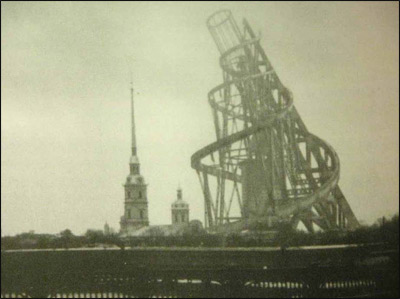Realistic Fake Vintage Photo of Tatlin Tower

At 1,300 feet, this structure of iron, glass and steel would have dwarfed the Eiffel Tower. Designed in 1919 by Vladimir Tatlin, the building – officially called The Monument to the Third International – was planned to be erected in St. Petersburg as the headquarters of the Comintern. The tower was designed to contain twin spirals tapering upwards and encasing a cube-shaped lecture hall, a smaller pyramid for executive meetings, and a cylinder housing an information center, delivering bulletins and manifestos via radio, telegraph and loudspeaker.
Each part of the building would rotate at a different speed. The cube was proposed to rotate and complete 360˚ after 365 days, the pyramid would complete a full 360˚ rotation every month, and the cylinder would complete its rotation within 24 hours. There were also plans to build an open-air screen on the cylinder, and for the cylinder to project messages onto the clouds. The building was never constructed due to financing and structural concerns, though an interesting build effort took place in 2006.
There’s also this short film by Lutz Becker. The first YouTube comment below the video captures it perfectly: it’s “mad, impossible, brutal, audacious and beautiful.”
[image via]

October 15th, 2010 at 1:33 pm
I remember learning about this in an art history class I took. I was so disappointed that it couldn’t actually be built! It’d would’ve truly been a marvel.
October 15th, 2010 at 2:51 pm
So astoundingly beautiful and ominous. I love it.
October 15th, 2010 at 4:08 pm
Hmm, I think that image is a cropped still from MIT professor Takehiko Nagakura’s “The Unbuilt Monuments: A Virtual Architecture Film Series.”
http://www.youtube.com/watch?v=lwuPCDhpcfY
October 16th, 2010 at 9:28 am
“mad, impossible, brutal, audacious and beautiful.”
Sounds like a pretty good description of communism, as well.
October 16th, 2010 at 1:46 pm
The architecture critic Owen Hatherley wrote a book called Militant Modernism covering various aspects of modernist architecture, film and science fiction, and had a section on the Soviet obsession with Mars and Martians (wonderful to read that in the context of the great article in the magazine about Soviet pulp a few issues back!). In there was a great piece of description and context about the tower:
“Yet HG Wells’ original Martians are, it should be remembered, a fantasy of anti-imperialist revenge. Wells was outraged by the British Empire’s extermination of the aboriginal population of Tasmania, and his alien invasion is a way of inflicting the very same treatment – obliteration by a more technologically advanced society – upon the West. In this sense, it’s not quite so surprising that one of the war cries of the Russian Futurists was War of the Worlds’ Martian roar ‘ULL-AA’, which would in 1919 provide the title for one of Viktor Shklovsky’s manifestos for the alienation effect, ‘Ullya, Ullya, Martians’. In order to truly *estrange*, to provide the distance from everyday life’s stock responses and learned indifference that, for Shklovsky, is the key element in great literature, art, or the circus, the alienation effect is taken literally to mean the visitation by that alien nation. Shklovsky writes of an avant-garde work being ‘worthy of my brothers, the Martians’. This is how much of the Russian Avant-Garde saw themselves – like Tatlin’s Third International Tower, whose iron legs and perpetual motion are akin to the Martians’ walking tripods, this was something as fearsome, uncanny and technologically terrifying as the alien invasion, and intended to be every bit as threatening to the existing society.”